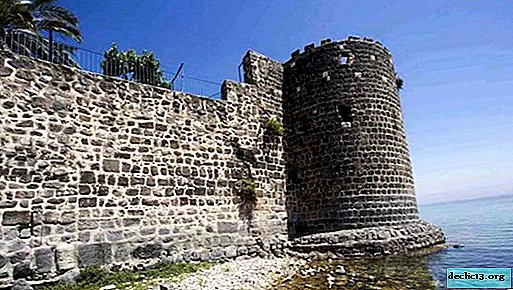"Rainbow" iris for a good mood
This beautiful plant has about 800 species, each of which is able to decorate any area in front of the house or garden. From the Greek language, the name of the flower is translated as "rainbow", since it is precisely its petals that are curved by the wave.


Iris Specific Features
Iris is a perennial plant that can easily winter in the garden. Its creeping rhizomes are either bulbs or branching roots.


The leaves of iris are particularly dense. They grow straight up and are large in size. The main decoration of the plant are large flowers, which differ in bright color and unusual shape.

The main suppliers of iris to Russia are considered South-West and Central Asia, as well as the Mediterranean. Flowering continues for a long period, so the garden can delight with colors even when the rest of the plants have already faded.


Plant varieties are classified:
- border irises;
- dwarf irises;
- medium-sized;
- tall bearded.


There is another gradation:
- bearded irises;
- beardless;
- bulbous;
- corms and other


Many varieties are suitable for growing in the Russian climate. Among them:
- He is the Wings;
- Sleep
- Pussicat Pink;
- Irish Chant;
- Wish Apon;
- Snow Cross
- Mountain Lake;
- Fancy Sparkler;
- Forever Blue;
- Bordeaux Pearl;
- Flavors and dozens of others.


Planting and growing irises
To start a successful cultivation of irises, you must carefully select and prepare the site. If the groundwater in the selected place rises very high, then the site is better to drain.


Irises are light lovers, so you should provide access to sunlight. To do this, the flower bed can be raised by about 15 cm, pouring additional soil.

If the soil on the site is not rich enough in nutrients, then it needs to be fertilized. You can use mineral and organic nutrition. Manure should be used only if the planting of irises is planned for next year.

Next, you can dig a flower bed and form a slope to the south side. If the planting has passed according to all the rules, then proper care will ensure the plant life cycle up to 10 years (for hybrid varieties up to 5 years).


Adult irises tend to grow, which will require a larger area. As they grow, they should be planted, as each hotel bush will lack nutrients.


In summer, you can observe the formation of new buds, from which over time amazingly beautiful flowers will grow. Since the buds form in the summer, in winter the plant has fully formed buds. When choosing varieties for cold regions, it should be remembered that there are tender plants whose buds can die at temperatures below -10 gr.

Iris seedlings can be planted when the rhizome has acquired new links. In this case, the flower bud should not yet be tied.


The best time for transplantation comes after the end of flowering iris. After planting, fresh shoots must be removed.


One-year-old processes are considered suitable for planting, with a stalk thickness of about 2 cm and a length of about 3 cm. Preparation for planting consists in cutting one third of the length of the leaves. You also need to shorten the root to 10 cm.


Planting irises should be carried out in the summer. In the second week, you can see the growth of the cuttings.


If planting a flower is expected in the fall, then for this you should choose the most durable formed cuttings. They should be larger than those that I plant in the summer. It will be easier for them to endure the winter and in the summer to give the first flowers. The main thing is that the plant is completely rooted before the soil freezes.


When planting, the rhizome should completely sink into the soil and be on the same level with it. Leaves should be directed upwards and held firmly without falling.


The hole for the plant in size should correspond to the rhizome. The sprout should be pressed and sprinkled with a layer of soil. After that, the flower is watered for the first time, and after 3 days - the second.


Seedlings are best placed at a distance of 30-40 cm from each other. Every 3-5 years it is necessary to plant bushes to prevent the rhizome from appearing on the surface.


Irises bloom brighter and more magnificent at the age of 2-3 years. With good care, this period can be extended for another 2 years. A vegetative planting method is suitable for all types of iris.


The large bush should be cleared of the earth. After this, the rhizome can be broken. It is important that on all the resulting parts there was a leaf part along with the root.


About half of the leaves will have to be cut, as well as a third of the root. Be sure to clean the seedlings from dry and diseased leaves and rotted sections of the root. After that, the material for planting is disinfected with a weak solution of manganese. Further actions do not differ from the scheme of planting cuttings.


Caring for iris on the site
It is easy to take care of properly planted irises. All care is reduced to loosening the earth, watering, weeding, fertilizing and removing weeds.


As a suitable soil, it is better to choose loam with a neutral pH level. In such soil, the plant can grow up to 7 years.


When watering should take into account the proximity of groundwater. Oversaturation of soil with water can lead to rotting of the rhizome and the appearance of dark spots on the plant itself. Since mid-July, watering is best reduced.


Irises respond well to dressing. The first stage takes place in the spring at its beginning. It is easiest to sprinkle the soil around the bush with soluble mineral fertilizer. 10 g are enough for one flower. substances.


In the period of tying buds, it is worthwhile to carry out a second top dressing. The next portion of the fertilizer must be made already in August. At this time, the plant goes through the second stage of vegetation. During this period, feeding will give the plant immunity so that it can easily overwinter. For feeding, it is better to choose phosphorus or potash fertilizer.


Prevention of diseases and the appearance of pests will allow the plant to bloom more luxuriantly and longer. Spraying with special substances should be carried out once every two weeks. The first time this procedure can be carried out when the leaves reach a size of 10 cm.


The rhizomes of the plant also need to be carefully inspected. The place of decay should be removed, and sprinkle the affected area with ash. Another method of getting rid of rot on the roots is to soak it in a solution of manganese. To do this, you need to carefully dig up the bush.


Old and damaged leaves need to be cut off and burned, as they may have pests that can damage healthy leaves over time.


After flowering, the flower stalks should also be removed. This will make it easier for the plant to winter and easier to get new flowers.

A healthy iris bush is distinguished by waxy green leaves. This can be achieved by observing simple rules for caring for the plant. Only in this case, the iris will give the garden a stunning view and will amaze visitors with bright spots of flowers.

















